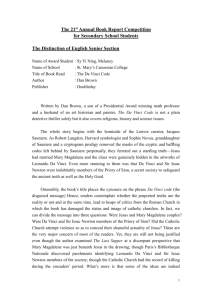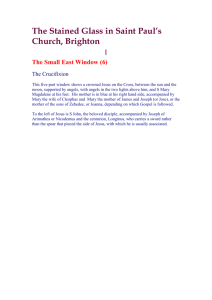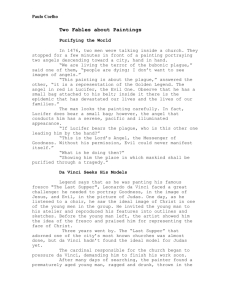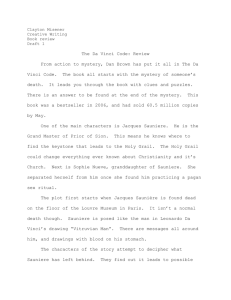Fiction in Da Vinci Code's facts
advertisement
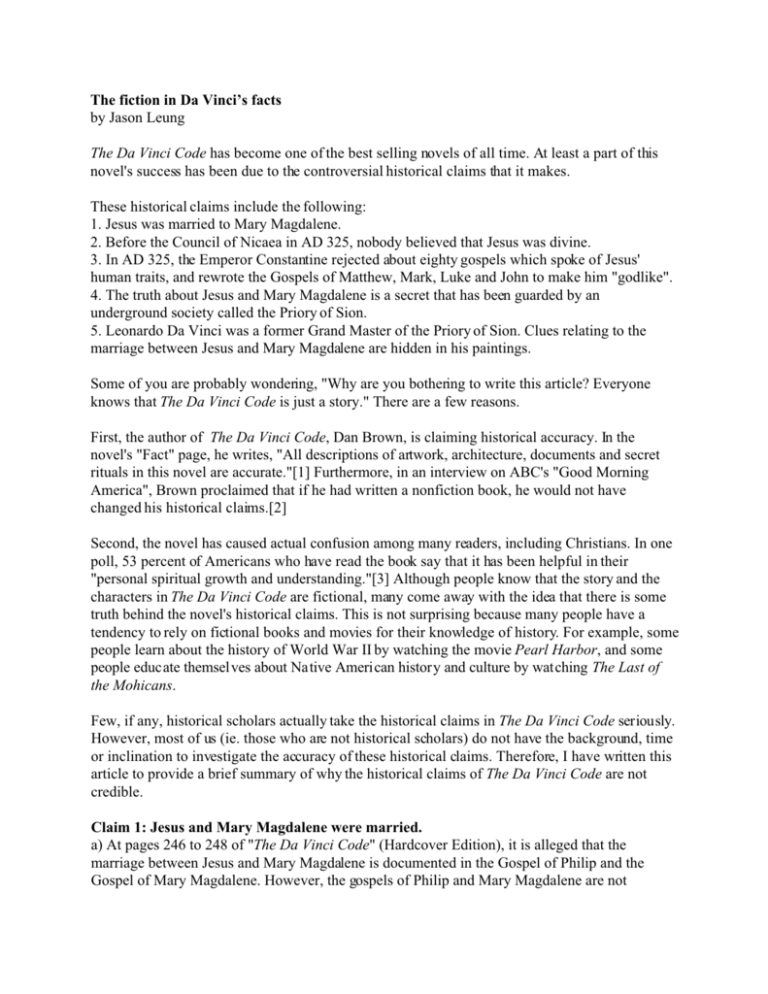
The fiction in Da Vinci’s facts by Jason Leung The Da Vinci Code has become one of the best selling novels of all time. At least a part of this novel's success has been due to the controversial historical claims that it makes. These historical claims include the following: 1. Jesus was married to Mary Magdalene. 2. Before the Council of Nicaea in AD 325, nobody believed that Jesus was divine. 3. In AD 325, the Emperor Constantine rejected about eighty gospels which spoke of Jesus' human traits, and rewrote the Gospels of Matthew, Mark, Luke and John to make him "godlike". 4. The truth about Jesus and Mary Magdalene is a secret that has been guarded by an underground society called the Priory of Sion. 5. Leonardo Da Vinci was a former Grand Master of the Priory of Sion. Clues relating to the marriage between Jesus and Mary Magdalene are hidden in his paintings. Some of you are probably wondering, "Why are you bothering to write this article? Everyone knows that The Da Vinci Code is just a story." There are a few reasons. First, the author of The Da Vinci Code, Dan Brown, is claiming historical accuracy. In the novel's "Fact" page, he writes, "All descriptions of artwork, architecture, documents and secret rituals in this novel are accurate."[1] Furthermore, in an interview on ABC's "Good Morning America", Brown proclaimed that if he had written a nonfiction book, he would not have changed his historical claims.[2] Second, the novel has caused actual confusion among many readers, including Christians. In one poll, 53 percent of Americans who have read the book say that it has been helpful in their "personal spiritual growth and understanding."[3] Although people know that the story and the characters in The Da Vinci Code are fictional, many come away with the idea that there is some truth behind the novel's historical claims. This is not surprising because many people have a tendency to rely on fictional books and movies for their knowledge of history. For example, some people learn about the history of World War II by watching the movie Pearl Harbor, and some people educate themselves about Native American history and culture by watching The Last of the Mohicans. Few, if any, historical scholars actually take the historical claims in The Da Vinci Code seriously. However, most of us (ie. those who are not historical scholars) do not have the background, time or inclination to investigate the accuracy of these historical claims. Therefore, I have written this article to provide a brief summary of why the historical claims of The Da Vinci Code are not credible. Claim 1: Jesus and Mary Magdalene were married. a) At pages 246 to 248 of "The Da Vinci Code" (Hardcover Edition), it is alleged that the marriage between Jesus and Mary Magdalene is documented in the Gospel of Philip and the Gospel of Mary Magdalene. However, the gospels of Philip and Mary Magdalene are not historically reliable documents, and certainly not as reliable as the Gospels of Matthew, Mark, Luke and John (the four gospels found in the Bible). The death and resurrection of Jesus happened in the AD30s. The Gospel of Philip was written sometime between AD180 and 250. The Gospel of Mary Magdalene was written sometime between AD120 and 180.[4] In other words, both the gospels of Philip and Mary Magdalene were written long after all the people who were eye witnesses to the life, death and resurrection of Jesus had already died. In contrast, the Gospels of Matthew, Mark, Luke and John were all written in the 1st century, beginning as early as the AD40s, and no later than the AD 90s.[5] These gospels were written during the lifetime of many actual eye witnesses to the life, death and resurrection of Jesus (for example, the disciple John died in the AD 90s). b) Even the names of these gospels, namely "The Gospel of Philip" and "The Gospel of Mary Magdalene", are fraudulent. Philip was one of the twelve disciples. Mary Magdalene was one of a group of women who followed Jesus. As mentioned above, the Gospels of Philip and Mary Magdalene were both written in the 2nd or 3rd century. Obviously, both Philip and Mary Magdalene had died by this time, and could not have been the real authors of these gospels. These gospels were written by unknown authors who were not witnesses to Jesus' life, death and resurrection. In contrast, the Gospels of Matthew, Mark, Luke and John were written by people who had a connection to Jesus. Matthew and John were two of Jesus'' twelve disciples. Mark was the interpreter for Peter, who was one of Jesus'' twelve disciples. Luke was a disciple of the Apostle Paul, who wrote a major portion of the New Testament.[6] c) Even if you consider the Gospels of Philip and Mary Magdalene to be reliable, neither of these documents states, explicitly or implicitly, that Jesus and Mary Magdalene were married. In the Gospel of Philip at 63:33-36, it reads, "And the companion of the [...] Mary Magdalene ... [andused to] kiss her [often] on her [...]". The brackets indicate broken locations in the old manuscript because the manuscript is damaged.[7] Although, The Da Vinci Code claims that the manuscript reads "kiss her often on her mouth", the truth is that we do not know whether the damaged manuscript actually refers to a kiss on the mouth, a kiss on the cheek, a kiss on the hand or a kiss somewhere else. In the Gospel of Mary Magdalene at 17:10 to 18:21, Mary Magdalene merely receives a revelation from Jesus.[8] There is no reference in this gospel to Mary Magdalene being the wife of Jesus. It is based on these two flimsy pieces of evidence from two unreliable historical documents, namely: (i) a possible kiss, which may have been on the mouth or on the cheek or somewhere else; and (ii) a revelation received by Mary, which The Da Vinci Code relies upon to jump to the conclusion that Jesus and Mary Magdalene were married. d) We have many ancient documents, both inside and outside the Bible, which describe Jesus including his birth, his ministry, his death and his resurrection. Not a single one of these documents states that Jesus was married. Many of these ancient documents mention his family members, including his mother and his brother, but never a wife. There is also no hint that Jesus may have been a widower. Claim 2: Before the Council of Nicaea in AD 325, nobody believed that Jesus was divine. a) According to The Da Vinci Code at page 233, before the Council of Nicaea, "Jesus was viewed by His followers as a mortal prophet", not the Son of God. This is false. We have many ancient documents that describe Jesus as being divine. These ancient documents are: (i) dated prior to AD 325; and (ii) outside of the Bible. For example, a writer named Ignatius of Antioch lived from about AD 50 to 117, and in his "Letter to the Ephesians", Ignatius wrote, "For our God, Jesus Christ, was, according to the appointment of God, conceived in the womb by Mary, of the seed of David, but by the Holy Ghost." As another example, an African writer named Tertullian lived from about AD 160 to 225, and in his book “The Soul”, Tertullian wrote, “God alone is without sin. The only man who is without sin is Christ; for Christ is also God.”[9] Several other writers lived long before the Council of Nicaea of AD 325, and wrote about their belief in the divinity of Jesus. These writers include: Justin Martyr (ca. 100 to ca. 165), Melito of Sardis (died about AD 190), Irenaeus (ca. 130 to ca. 200), Clement of Alexandria (ca. 150 to ca. 215), Origen (ca. 185 to ca. 254), and Gregory Thaumaturgus (ca. 213 to ca. 270). b) We also have the books of the Apostle Paul which are dated between the years AD 50 and AD 68.[10] These books clearly refer to the divinity of Jesus. For example, in 1 Corinthians 8:6, Paul wrote, "there is but one Lord, Jesus Christ, through whom all things came and through whom we live." c) Further, we have the Gospels of Matthew, Mark, Luke and John. All of these gospels were written in the 1st century, and all clearly refer to Jesus' divinity. For example, these gospels describe Jesus as having the following divine characteristics: (i) omnipresent (Matthew 18:20; 28:20); (ii) omniscient (John 6:64; Matthew 17:22-23); and (iii) omnipotent (Luke 4:39-41; 7:14-15; Matthew 8:26-27). d) At page 233 of The Da Vinci Code, the novel alleges that it was by a “relatively close vote" that the Council of Nicaea endorsed the divinity of Jesus. Actually, various reports indicate that the vote was somewhere between: (i) 218 for and 2 against; and (ii) 300 for and 2 against. All of these reports agree that there were only 2 votes against, specifically by two Libyan bishops named Secundus of Ptolemais and Theonas of Marmarica.[11] I am not sure how anyone could reasonably label this as being a “relatively close vote", and then claim to be historically accurate. e) At page 233 of The Da Vinci Code, the novel states that establishing the divinity of Jesus at the Council of Nicaea was critical to "the new Vatican power base". There is a problem with this statement. During this time period, the Vatican did not exist. The land occupied by today''s Vatican would not become the Pope's official residence until the 14th century![12] Claim 3: In AD 325, the Emperor Constantine rejected about eighty gospels which spoke of Jesus' human traits, and rewrote the Gospels of Matthew, Mark, Luke and John to make him"godlike." a) At page 234 of The Da Vinci Code, it is stated that, “some of the gospels that Constantine attempted to eradicate managed to survive. The Dead Sea Scrolls were found in the 1950s hidden in a cave near Qumran in the Judean desert." First, it should be pointed out that the Dead Sea Scrolls were first discovered in 1947, not in the 1950s.[13] More importantly, the Dead Sea Scrolls contain more than eight hundred manuscripts, of which about two hundred scrolls are Old Testament documents. However, the Dead Sea Scrolls do not contain a single gospel, as claimed in "The Da Vinci Code". Not a single document in the Dead Sea Scrolls contain any mention of Jesus![14] Again, Dan Brown demonstrates that his historical research is careless, and that he does not have a firm understanding of these ancient documents. b) Further, it was not Constantine who decided that only the Gospels of Matthew, Mark, Luke and John were acceptable. We have several ancient documents from writers who lived before AD 325 which indicate that the four gospels of the Bible were already accepted as the only gospels to accurately record the life, death and resurrection of Jesus. For example, a second century writer named Justin Martyr wrote a document called "Dialogue with Trypho", which is dated between the years AD 150 and 160. In "Dialogue with Trypho", Justin mentioned the "memoirs of the apostles" fifteen times, and specifically referred to the Gospels of Matthew, Mark and Luke.[15] As another example, in Book 3.11.7 of "Against Heresies" by second century writer Irenaeus, Irenaeus described the Gospels of Matthew, Mark, Luke and John as the gospels which reflected the core testimony about Jesus.[16] c) Contrary to the claims of The Da Vinci Code, the Gospels of Matthew, Mark, Luke and John were not altered to make Jesus "godlike". We have ancient manuscript fragments from the New Testament that are dated as early as the second half of the first century (ie. before AD 100). We have more than forty manuscript fragments from the New Testament that are dated before AD 300, several of which are dated in the AD 100s. Scholars have compared: (i) these earliest manuscripts; and (ii) newer copies of manuscripts dated centuries later, and have found that the New Testament has been virtually unaltered![17] Another important fact is that we have several ancient writings from secular historians (ie. historians who did not worship Jesus) which confirm many of the events, people, places and customs described in the New Testament. These secular historians include Josephus (before AD 100), the Roman Tacitus (about AD 120), the Roman Suetonius (about AD 110), and the Roman governor Pliny the Younger (about AD 110).[18] These historians had no incentive to support the events documented in the New Testament. They were simply recording what happened. Claim 4: The truth about Jesus and Mary Magdalene is a secret that has been guarded by an underground society called the Priory of Sion. a) The novel''s claims regarding the history of the Priory of Sion are based on a group of documents, called the "dossiers secrets", that were discovered in the Bibliotheque Nationale in Paris. However, the "dossiers secrets" were actually implanted into the Bibliotheque Nationale during the 20th century (ie. the 1900s) by a man named Pierre Plantard. Plantard had a criminal record and served time in jail for fraud and embezzlement. One of Plantard's henchmen admitted to assisting him in the fabrication of these documents, including the list of the Priory of Sion's Grand Masters found at pages 326 to 327 of The Da Vinci Code.[19] b) The Priory of Sion was not founded in Jerusalem in 1099. Instead, it was founded in 1956, and it was registered with the St. Julien-en-Genevois bureau of records in France. Two of the original members were Andre Bonhomme, president, and the above-mentioned Pierre Plantard, secretarygeneral. The original president, Andre Bonhomme, made this statement on BBC: "The Priory of Sion does not exist anymore. We were never involved in any activities of a political nature. It was four friends who came together to have fun. We called ourselves the Priory of Sion because there was a mountain by the same name close by. I haven't seen Pierre Plantard in over 20 years and I don't know what he's up to but he always had a great imagination. I don't know why people try to make such a big thing out of nothing."[20] c) Even if you consider Pierre Plantard to be a reliable source, there is little evidence to link the Priory of Sion to Jesus. Plantard did not make any statement that there was a link between the Priory of Sion and Jesus. Plantard merely claimed that the Priory of Sion held the lost treasure of the Temple of Jerusalem.[21] d) Plantard showed little, if any, interest in the alleged marriage between Jesus and Mary Magdalene. Instead, Plantard stated that one of the main purposes of the Priory of Sion was to restore the line of Merovingian kings to the French throne. Specifically, Plantard claimed that he was a descendant of the Merovingian King Dagobert II, and therefore, he himself was the rightful heir to the French throne. Eventually, Plantard would admit under oath that his claim to the French throne was fraudulent.[22] Claim 5: Leonardo Da Vinci was a former Grand Master of the Priory of Sion. Clues relating to the marriage between Jesus and Mary Magdalene are hidden in his paintings. a) Leonardo Da Vinci was born in 1452 and died in 1519.[23] As mentioned above, the Priory of Sion was not actually founded until 1956. Therefore, Da Vinci was never a Grand Master, or even a member, of the Priory of Sion. b) At page 243 of The Da Vinci Code, Leonardo Da Vinci’s painting of "The Last Supper" is discussed. It is alleged that the character to Jesus' right (left as we look) is Mary Magdalene. It is pointed out that this character has no beard and has some effeminate features. In reality, this character is the disciple John. If you look at other Christian art from this time period (15th century Florentine style), you will see that John was often portrayed without a beard. This was done to show that he was the youngest of the twelve disciples. Furthermore, if you study Leonardo Da Vinci's paintings, you will see that he painted men with effeminate features. For example, Da Vinci's painting of "Saint John the Baptist" shows a man who is very effeminate in appearance, including long hair, hairless skin, and delicate hands.[24] c) At page 244 of The Da Vinci Code, it is alleged that Jesus and the John/Mary character lean away from each other to form a V-shape, which is a symbol for the female womb. This theory relating to the significance of the V-shape is nothing but a shot in the dark. If you look at the right side of the painting, you will see a second V-shape formed between two other characters. Experts believe that these two other characters are the disciples Philip and Matthew. However, nobody is arguing that one or both of these two characters is female. d) It is well accepted that Jesus had twelve male disciples, and that all twelve of these male disciples were present at the Last Supper. In Da Vinci's painting of "The Last Supper", there are thirteen characters, including Jesus. If it is indeed Mary Magdalene who is to the right of Jesus, then shouldn't there be fourteen characters? Other Claims This section deals with some of the other claims in The Da Vinci Code that are not directly related to the novel''s Jesus and Mary Magdalene theory. a) At page 36 of The Da Vinci Code, it is stated, “As a tribute to the magic of Venus, the Greeks used her eight-year cycle to organize their Olympic Games.” In reality, the Ancient Olympic Games were dedicated to Zeus and, perhaps, Hera, but not Venus. The Ancient Olympic Games were held at Olympia, where the Temple of Zeus and the Temple of Hera were located. Also, the Ancient Olympic Games were held every four years, not every eight years.[25] b) In The Da Vinci Code at pages 88 and 105 to 106, the Saint-Sulpice Church in Paris is described as follows: (i) the church was built over the ruins of a temple to the Egyptian goddess Isis; (ii) the line on the floor of Saint-Sulpice is the same as the Paris Meridian or “Rose Line”. Remember that in the novel's "Fact" page, Dan Brown states that, "All descriptions of ... architecture ... in the novel are accurate." To answer these claims, this note has been on display in the church: "Contrary to fanciful allegations in a recent best-selling novel, this [the line in the floor] is not a vestige of a pagan temple. No such temple ever existed in this place. It was never called a Rose-Line. It does not coincide with the meridian traced through the middle of the Paris Observatory which serves as a reference for maps where longitudes are measured in degrees East or West of Paris." In fact, the Paris Meridian passes about 100 yards east of the line on the floor of Saint-Sulpice.[26] c) At page 257, The Da Vinci Code claims that, “The Merovingians founded Paris.” This is not true. Around 250 BC, a tribe called the Parisii established a village in the area occupied by modern day Paris. The Romans conquered the area in 52 BC, and built a city called Lutetia. The first mention of the name “Paris” appeared at about AD 207, and was commonly used by about AD 310. The Merovingians did not move their capital to Paris until about AD 500.[27] d) At page 435, The Da Vinci Code describes the Rosslyn Chapel in Scotland as having a Star of David-shaped pathway worn into the floor. Although the Rosslyn Chapel contains many interesting architectural features, there is no Star of David-shaped pathway worn into the floor.[28] Final Thoughts Not surprisingly, Dan Brown has declined to respond to any challenges to the historical accuracy of The Da Vinci Code. Recently, he stated, "Let the biblical scholars and historians battle it out." If Brown truly believes in what he is writing, then why doesn't he answer these challenges? There are three likely reasons: (i) Brown's goal is to make money by selling books. He has found that he can sell millions of books by creating conspiracies. He has no incentive to provide people with an accurate account of history. (ii) Brown knows that his novel's theory relies on fraudulent documents. He knows that he cannot answer these challenges with any substantial evidence to support his novel''s claims. (iii) Brown is a writer of fictional novels. He is not an expert in either Biblical scholarship or history. If he were to engage any Biblical scholar or any historian in any sort of debate, his lack of expertise would be exposed. I realize many of you are fans of Dan Brown''s novels. Please do not to take offence to this article. I am not saying that Brown's novels are bad stories. Whether The Da Vinci Code is a good or bad story is a matter of personal opinion. However, I am saying that The Da Vinci Code is bad history. This is not a matter of personal opinion. It is a fact that has become obvious to those who have done some investigation into the matter. Jason Leung is a Christian lawyer living in the Toronto area. FOOTNOTES [1] Dan Brown, "The Da Vinci Code" (New York: Doubleday, 2003). [2] Darrell L. Bock, “Breaking The Da Vinci Code” (Nashville: Nelson Books, 2004), 3. [3] www.leestrobel.com/newsletters. [4] www.earlychristianwritings.com. See also Hank Hanegraaf and Paul L. Maier, “The Da Vinci Code: Fact or Fiction?” (Wheaton, Illinois: Tyndale House Publishers, 2004), 19. [5] Josh McDowell, “More Than A Carpenter” (Wheaton, Illinois: Living Books, 1977), 42-44. [6] Josh McDowell, “More Than A Carpenter” (Wheaton, Illinois: Living Books, 1977), 55-56. [7] Darrell L. Bock, “Breaking The Da Vinci Code” (Nashville: Nelson Books, 2004), 21-23. See also http://en.wikipedia.org/wiki/Gospel_of_Philip. [8] Darrell L. Bock, “Breaking The Da Vinci Code” (Nashville: Nelson Books, 2004), 24-27. [9] Carl E. Olson and Sandra Miesel, “The Da Vinci Hoax” (San Francisco: Ignatius Press, 2004), 116-122. [10] Darrell L. Bock, “Breaking The Da Vinci Code” (Nashville: Nelson Books, 2004), 104. [11] Simon Cox, “Cracking The Da Vinci Code” (New York: Sterling Publishing Co., 2004), 48. See also Carl E. Olson and Sandra Miesel, “The Da Vinci Hoax” (San Francisco: Ignatius Press, 2004), 171-172. See also Hank Hanegraaf and Paul L. Maier, “The Da Vinci Code: Fact or Fiction?” (Wheaton, Illinois: Tyndale House Publishers, 2004), 15. [12] http://en.wikipedia.org/wiki/Lateran_Palace. See also Carl E. Olson and Sandra Miesel, “The Da Vinci Hoax” (San Francisco: Ignatius Press, 2004), 34. [13] Hank Hanegraaf and Paul L. Maier, “The Da Vinci Code: Fact or Fiction?” (Wheaton, Illinois: Tyndale House Publishers, 2004), 33. [14] Carl E. Olson and Sandra Miesel, “The Da Vinci Hoax” (San Francisco: Ignatius Press, 2004), 176-177. [15] Darrell L. Bock, “Breaking The Da Vinci Code” (Nashville: Nelson Books, 2004), 118. [16] Darrell L. Bock, “Breaking The Da Vinci Code” (Nashville: Nelson Books, 2004), 112-114. [17] Hank Hanegraaf and Paul L. Maier, “The Da Vinci Code:Fact or Fiction?” (Wheaton, Illinois: Tyndale House Publishers, 2004), 43-44, 74-76. [18] Hank Hanegraaf and Paul L. Maier, “The Da Vinci Code: Fact or Fiction?” (Wheaton, Illinois: Tyndale House Publishers, 2004), 44-45. [19] Hank Hanegraaf and Paul L. Maier, “The Da Vinci Code: Fact or Fiction?” (Wheaton, Illinois: Tyndale House Publishers, 2004), 10-12. See also Carl E. Olson and Sandra Miesel, “The Da Vinci Hoax” (San Francisco: Ignatius Press, 2004), 236. [20] Darrell L. Bock, “Breaking The Da Vinci Code” (Nashville: Nelson Books, 2004), 185-186. [21] Simon Cox, “Cracking The Da Vinci Code” (New York: Sterling Publishing Co., 2004), 71-72. [22] Carl E. Olson and Sandra Miesel, “The Da Vinci Hoax” (San Francisco: Ignatius Press, 2004), 238. See also Simon Cox, “Cracking The Da Vinci Code” (New York: Sterling Publishing Co., 2004), 132. See also http://en.wikipedia.org/wiki/Pierre_Plantard. [23] http://en.wikipedia.org/wiki/Leonardo_da_Vinci. [24] Carl E. Olson and Sandra Miesel, “The Da Vinci Hoax” (San Francisco: Ignatius Press, 2004), 267-270. [25] http://en.wikipedia.org/wiki/Ancient_Olympic_Games. See also http://www.historyforkids.org/learn/greeks/games/olympics.htm. See also http://www.olympic.org/uk/games/ancient/history_uk.asp. [26] http://en.wikipedia.org/wiki/Saint-Sulpice_(Paris) [27] http://en.wikipedia.org/wiki/Lutetia. See also http://uk.holidaysguide.yahoo.com/p-travelguide-219747-paris_history-i. See also Hank Hanegraaf and Paul L. Maier, “The Da Vinci Code: Fact or Fiction?” (Wheaton, Illinois: Tyndale House Publishers, 2004), 33, 74. [28] http://www.rosslynchapel.org.uk/htm/architecture.htm. See also Simon Cox, “Cracking the Da Vinci Code” (New York: Sterling Publishing Co., 2004), 137-138. "...there will be false teachers among you. They will secretly introduce destructive heresies, even denying the sovereign Lord who bought them bringing swift destruction on themselves. Many will follow their shameful ways and will bring the way of truth into disrepute. In their greed these teachers will exploit you with stories they have made up." 2 Peter 2:1-3
